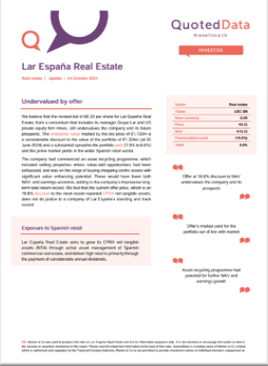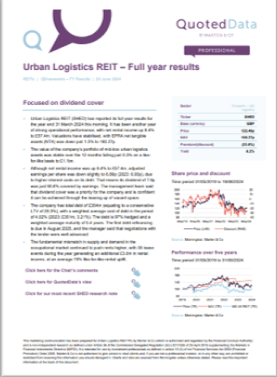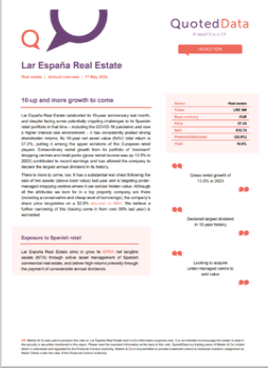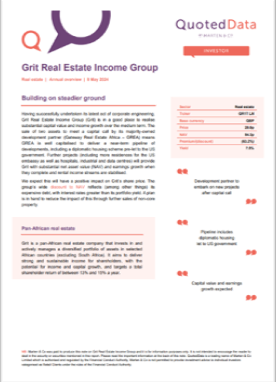Winners and losers in November 2024
| Best performing funds in price terms | (%) |
|---|---|
| Alpha Real Trust | 9.5 |
| Globalworth Real Estate | 8.5 |
| Residential Secure Income | 5.3 |
| IWG | 4.5 |
| Custodian Property Income REIT | 3.2 |
| Grainger | 3.1 |
| Value & Indexed Property Income Trust | 1.9 |
| Hammerson | 1.8 |
| Workspace Group | 1.8 |
| Supermarket Income REIT | 1.3 |
| Worst performing funds in price terms | (%) |
|---|---|
| Grit Real Estate Income Group | (17.6) |
| CLS Holdings | (12.3) |
| Life Science REIT | (12.2) |
| Conygar Investment Company | (11.5) |
| Big Yellow Group | (11.3) |
| Real Estate Investors | (8.8) |
| Safestore | (8.0) |
| Ground Rents Income Fund | (7.6) |
| Target Healthcare REIT | (7.4) |
| Urban Logistics REIT | (7.3) |
Best performing funds

Real estate share prices settled somewhat in November but were still down 1.4% on average having declined almost 5% in October, as the impact of the budget raised the potential for a higher-for-longer interest rates environment. There was an eclectic mix of positive share price movers in the month, led by real estate debt specialist Alpha Real Trust. Post month end, the company announced that it would seek to delist, offering minority shareholders a tender offer at NAV. Residential Secure Income saw its share price trend upwards for a second consecutive month after announcing a proposed managed wind-down in October. Custodian Property Income REIT’s quarterly valuation update shows that values may have turned a corner (see the valuation moves section below), highlighting that its shares may be too cheap. Hammerson’s continued operational and balance sheet strengthening, including the launch of a £140m share buyback programme, seems to be gaining traction with investors. The reaction to the proposed change in the basis of Supermarket Income REIT’s management fee (from NAV to share price – see corporate news section) has been surprisingly muted.
Worst performing funds

Potentially higher-for-longer interest rates resulted in many of the highly leveraged or rate sensitive companies suffer once again. Grit Real Estate Income Group, which has a high cost of borrowing, continued to lose value as its share price plummeted another 17.6% over the month, and it has halved in size over the 11 months of 2024. The African real estate developer and investor now has an astonishingly low market cap of around £50m, despite owning a freshly capitalised development partner with lucrative US Embassy-backed diplomatic housing projects in the pipeline. Fellow perennial 2024 share price victims CLS Holdings and Life Science REIT also recorded double-digit declines in November. Office landlord CLS faces a tricky few months with several loans due to mature in 2025. Meanwhile, interest rate hedges in place on debt that Life Science REIT is using to develop its flagship scheme expire next year. The two self-storage operators, Big Yellow and Safestore, both suffered as fears for subdued economic growth and a floundering housing market grew. Ground Rents Income Fund made significant progress in its strategy to sell down assets with the sale of its largest holding (see the news section).

Valuation moves
| Company | Sector | NAV move (%) | Period | Comments |
|---|---|---|---|---|
| Care REIT | Healthcare | 0.6 | Quarter to 30 Sept 24 | 1.0% like-for-like increase in property portfolio valuation to £672.1m |
| Custodian Property Income REIT | Diversified | 0.4 | Quarter to 30 Sept 24 | Value of the company’s portfolio was £582.4m, an increase of 0.5% on a like-for-like basis |
| abrdn European Logistics Income | Europe | (0.3) | Quarter to 30 Sept 24 | Portfolio valuation remained stable at €607.5m |
| Triple Point Social Housing REIT |
Residential | (1.4) | Quarter to 30 Sept 24 | 0.9% decrease in the valuation of the company’s property portfolio |
| abrdn Property Income Trust | Diversified | (11.3) | Quarter to 30 Sept 24 | Reduction reflects price agreed on sale of company’s portfolio |
| AEW UK REIT | Diversified | 6.2 | Half-year to 30 Sept 24 | Value of portfolio up 2.3% to £215.6m |
| Warehouse REIT | Industrial | 2.5 | Half-year to 30 Sept 24 | Like-for-like portfolio valuation up 2.3% to £811.3m |
| LondonMetric Property | Logistics | 2.1 | Half-year to 30 Sept 24 | 0.7% property valuation increase to £6.2bn |
| Land Securities | Diversified | 1.4 | Half-year to 30 Sept 24 | Portfolio valuation up 0.9% to £9,957m |
| Sirius Real Estate | Europe | 1.2 | Half-year to 30 Sept 24 | Marginal valuation uplift to €2,349.0m |
| Schroder REIT | Diversified | 1.0 | Half-year to 30 Sept 24 | Portfolio valuation increased by 0.9% to £465.5m |
| British Land | Diversified | 0.9 | Half-year to 30 Sept 24 | Values up 0.2% to £8,867m |
| Alpha Real Trust | Debt | 0.7 | Half-year to 30 Sept 24 | Uplift in earnings from high return debt |
| Picton Property | Diversified | 0.3 | Half-year to 30 Sept 24 | Like-for-like portfolio valuation increase of 0.8% to £721m |
| Assura Group | Healthcare | 0.2 | Half-year to 30 Sept 24 | Portfolio valued at £3.1bn following private hospital portfolio buy. Remainder of portfolio flat |
| Helical | Offices | 0.0 | Half-year to 30 Sept 24 | Valuation uplift of 1.3% to £371.9m |
| Urban Logistics REIT | Logistics | (1.4) | Half-year to 30 Sept 24 | Value of portfolio up 0.2% on like-for-like basis to £1.14bn |
Corporate activity in November

Home REIT fully repaid its debt to Scottish Widows, with a final repayment of £28.6m made on 27 November 2024. The company was charged a further £9m by Scottish Widows in respect of the additional fees, the payment of which will see the lender release its charge over the company’s assets and allow the company to sell its remaining property portfolio of 850 assets. This is currently being marketed for sale, quoting in excess of £175m. Since the month end, the company received a tender offer from Southey Capital at 4p per share, valuing the company at £32m.
British Land raised £301m in a placing, retail offer and subscription and will use the proceeds to part fund the acquisition of a portfolio of retail parks for £441m (see below for details). In aggregate 71,227,309 new ordinary shares were placed at a price of 422p, which represents a discount of 3.6% to the closing price on 2 October 2024.
Shareholders of both NewRiver REIT and Capital & Regional voted in favour of the merger of the two companies.

Supermarket Income REIT proposed changing the basis for calculating its management fee with Atrato Capital from NAV to market capitalisation. If approved by shareholders, the move will become effective from 1 July 2025. The current fee thresholds and rates applied to the NAV-based calculations will be retained in the updated agreement. It is also proposed that the company will transfer its outsourced AIFM, company secretarial and payments processing functions to the investment adviser, subject to a separate fee.
The board of Residential Secure Income proposed a managed wind-down of the company following a review of options for maximising shareholder value. The company’s persistent and material share price discount to NAV and its small market cap of around £101m (which it said may be a deterrent to some potential investors due to lower share liquidity) led the board and manager (Gresham House) to conclude that executing a managed wind-down and portfolio realisation strategy is the best course of action for shareholders. To implement this proposal, the board said that it intends to propose resolutions to change the company’s investment policy.
Great Portland Estates signed a new £150m ESG-linked unsecured revolving credit facility (RCF) at a headline margin of 90 basis points (0.9%) over SONIA. The facility has an initial three-year term which may be extended to a maximum of five years. The RCF extends the group’s weighted average debt maturity to over seven years. Three banks participated in the facility – Lloyds Bank, Bank of China and CaixaBank.
Urban Logistics REIT commenced a share buyback programme with a maximum consideration of up to £7.5m.
Sirius Real Estate announced that Fitch Ratings reaffirmed its long-term issuer default rating and senior unsecured rating at BBB, with a ‘Stable Outlook’.

November’s major news stories – from our website
- SEGRO nabs EuroBox assets for €470m
SEGRO agreed a deal with Brookfield Asset Management to purchase six properties from the Tritax EuroBox portfolio prior to Brookfield’s acquisition of Tritax EuroBox being ratified (mentioned in the previous section). The portfolio comprised assets in Germany and the Netherlands and was sold for a total of €470m.
- LondonMetric sheds 24 assets for £57.9m …
LondonMetric Property sold 24 properties across various non-core sectors for a total of £57.9m, reflecting a 6% profit over prevailing book values. The sales included an Asda foodstore in Halesowen, sold for £28.0m. Since 31 March 2024, the company has sold 52 assets for £209m, reflecting a net initial yield of 7.6%.
Separately, LondonMetric acquired a retail park on the outskirts of Basildon for £10.0m, reflecting a net initial yield of 6.7% rising to 7.3% following upcoming rent reviews.
- Supermarket Income REIT bags £50m Sainsbury’s store
Supermarket Income REIT acquired a Sainsbury’s omnichannel supermarket in Huddersfield, West Yorkshire, for £49.7m, reflecting a net initial yield of 7.6%.
- Great Portland Estates buys West End refurb project
Great Portland Estates acquired Whittington House in London’s West End for £58.5m. The building is currently let on a short-term basis, with vacant possession expected in the first quarter of 2025. Located close to the Tottenham Court Road Elizabeth Line station, the 74,500 sq ft HQ building will be refurbished and delivered in early 2027.
- Ground Rents Income Fund sells largest asset as part of realisation strategy
Ground Rents Income Fund sold its largest asset, a freehold ground rent interest at Lawrence Street in York, for £7.9m, reflecting a 4.2% net initial yield and in line with book value. The disposal is in line with the company’s strategy to sell assets to optimise the net realisation value of its investments. The proceeds will be used to repay debt.
- Workspace sells Rainbow park for £20.3m
Workspace Group sold Rainbow Industrial Estate, a redevelopment site in Raynes Park, for £20.3m (£1.0m below the March 2024 valuation) at a net initial yield 3.5%. Workspace had secured planning consent for a mixed-use redevelopment of the site comprising 224 residential units and 37,000 sq ft of new light industrial space.
- Hammerson completes Westquay buy
Hammerson completed the acquisition of a 50% stake in Westquay shopping centre for £135m. The consideration was funded by the proceeds received from Hammerson’s recent disposal of its stake in Value Retail.
- Helical completes JJ Mack sale
Helical completed the sale of its 50% interest in The JJ Mack Building, London EC1, to its joint venture partner, AshbyCapital, for £71.4m, with a dilution of 4p per share to the 31 March 2024 EPRA net tangible assets (NTA).
- Urban Logistics REIT recycles into higher yielding asset
Urban Logistics REIT sold a property in Peterborough for £7.7m at a net initial yield of 4.85% and acquired an asset in Dunstable for £3.6m at a net initial yield of 7.1%.
Visit https://www.QuotedData.com for more on these and other stories plus analysis, comparison tools and basic information, key documents and regulatory announcements on every real estate company quoted in London
Managers views
A collation of recent insights on real estate sectors taken from the comments made by chairmen and investment managers of real estate companies – have a read and make your own minds up. Please remember that nothing in this note is designed to encourage you to buy or sell any of the companies mentioned.

Healthcare
Assura Group – Jonathan Murphy, chief executive
The changes currently being seen in the UK healthcare market mean there are substantial and varied opportunities for Assura to explore.
The NHS is in crisis. An ageing population, increasingly complex long-term medical conditions and cost inflation, all of which can be seen in the well-documented increase in waiting lists, mean the pressure and challenges faced by the NHS today are greater than ever. This has been highlighted extensively by senior politicians in the new Labour Government.
The recently published report by Lord Darzi painted a bleak picture of the NHS, and highlighted how the material underinvestment in NHS buildings and primary care in general had contributed to the problem. We look forward to the release of the NHS 10-year plan which is due to be published next Spring.
New investment in modern primary care capacity can provide many answers that are more convenient for patients and cheaper for the healthcare system. NHS data shows that primary care treatment can be up to ten times less expensive than hospital treatment. Assura has the skills and track record to deliver primary care buildings that meet these needs.
Meanwhile, the private sector has continued to experience a surge in demand. The private market in the UK has grown substantially to £6.8 billion per annum in revenue, following a 6.3% compound annual growth rate over the past 20 years. Growth prospects are particularly favourable at this time. The UK private sector remains very small in proportion to the NHS budget, and in comparison to other European countries.
The sector creates additional capacity for the health system, with a payor mix split across three main strands: NHS referrals, private medical insurance (“PMI”) and self-pay. Patients are increasingly turning to private providers given the delays to treatment resulting from NHS waiting lists. Each individual asset is bespoke to the local healthcare needs with some focusing on NHS-referred work, while others have a higher proportion of PMI or self-pay.
These private providers generally offer specialisms that are well suited to specialist day-case and outpatient facilities. In particular ophthalmology and orthopaedics are well established, with a focus on efficient treatment for patients as well as high levels of customer service. It also means they are willing to invest in technology to improve operating metrics and seek a specialist healthcare landlord alongside whom they can develop their long-term plans.
Given the strong underlying growth in demand for health services, both the NHS and private healthcare markets offer exciting long-term growth potential.

Diversified
British Land – Simon Carter, chief executive
Companies want best-in-class space to attract and retain talent, a trend we’ve seen grow in importance post Covid. Although hybrid working seems here to stay, businesses are increasingly mandating their employees to spend more time in the office. As such peak office utilisation (Tuesday-Thursday) on our campuses is back to pre-Covid levels.
The bifurcation in the market between best-in-class space and the rest continues. Very tight supply of the best space in core locations combined with an increasing propensity for customers to favour new and newly refurbished space is driving strong rental growth, a trend that British Land is benefiting from. Vacancy for new or refurbished space in core Central London is at 1.7%, while vacancy for the rest of space in Central London is 10.9%. This is especially stark in the City, where forecast supply is c.3.7m sq ft over the next four years, made up of 0.8m sq ft of vacant new space today, 2.3m sq ft of speculative space under construction to 2028 and 0.6m sq ft of forecast new starts. Over the same period, we would anticipate 8.9m sq ft of demand for new and refurbished space based on historic take-up, meaning a shortfall of 5.2m sq ft of space.
The result is that we are seeing strong rental growth for super prime (top 10% of space) in the City. Over the last six months we have seen asking rents for pre-lets of super prime buildings like 2 Finsbury Avenue and 1 Broadgate increase by more than 10% with Cushman & Wakefield forecasting rents for this type of space to grow by c.8% per annum over the next four years.
Historically, the tight supply demand dynamics in core locations have had a ripple effect in adjacent markets in London, as occupiers explore new locations which can meet their demand for high quality workspace, with good amenities, and transport connectivity, but at a lower price point. In recent years, activity in these markets has been subdued but take up of new space increased by 67% this year and there is a growing pipeline of deals under offer.
Land Securities – Mark Allan, chief executive
Whilst global geopolitical uncertainty has increased, for the UK the general election over the summer has created an element of political stability that has eluded the country for nearly a decade, ever since the EU referendum. Whilst political decisions always require an element of compromise, we are mindful of the risk that the cost of increased taxes could slow down business decision-making. The new Government’s ambition to drive growth is admirable though and unlocking urban residential development appears a key part of its focus, which should bode well for the prospects of our growing residential pipeline.
In line with the view we set out in May, investment activity has picked up in London and retail and values have begun to return to growth for the best assets. Credit availability remains supportive, so we expect this trend to persist, although changes in long term interest rates will likely influence the pace at which momentum continues to improve from here. Customer demand for our best-in-class space remains robust and as supply is limited, we continue to expect ERVs for our London and retail portfolio to grow by a low to mid single digit percentage this year.
Picton Property – Michael Morris, chief executive
We have now seen a change of Government and two reductions in the base rate. UK commercial property capital values have started to react positively with the MSCI UK Quarterly Property Index showing recent increases in some sub-markets. Moving forward, we expect to see signs of a more stable macro environment and, following the repricing of the retail and office sectors, we expect medium-term returns across all sectors to be more convergent, with stock selection and asset management becoming increasingly important.
With the repricing in the commercial property market since 2022, in many instances values are below the cost of construction. We have been encouraged by the recent investment opportunities being marketed and have been undertaking due diligence on assets, primarily in the retail and industrial sectors.
There has undoubtedly been some business uncertainty around the change of Government and the Autumn Budget. Despite this, occupational markets remain resilient, with rents moving forward, especially for better quality accommodation.
AEW UK REIT – Robin Archibald, chairman
With the UK and US elections behind us, and the Bank of England implementing two rate cuts, there are plenty of political and economic events to digest, some of which will have a direct, or at least indirect, impact on UK commercial property in the short to medium term. There are always events to respond to, which is why good investment management anticipates and responds to these in an effective way.
The six-month period to September 2024 saw the economic and political pressures that have constrained the UK commercial real estate market begin to subside. The period commenced with April 2024 marking the end of an 11-month run of consecutive valuation declines at the property level. The MSCI/AREF UK PFI All Balanced Open-Ended Funds Quarterly Property Index delivered a modest total return of 2.7% for the period, driven almost entirely by an income return of 2.4%, which has been most evident in the retail warehousing and industrial sectors. This same theme has been amplified in the company’s portfolio, which delivered a strong income return of 4.5%. Despite the relatively muted economic backdrop, the company’s portfolio has delivered good capital growth of 4.4% during the same period, well exceeding the Index’s average of 0.4%. Overall, the company has delivered a total return of 9.1% for the period, significantly outperforming the benchmark.

Offices
Helical – Matthew Bonning-Snook, chief executive
As we approach 2025, the central London office market is showing encouraging signs of life, despite the ongoing economic and geopolitical challenges. The broader economy is also beginning to stabilise, with falling interest rates creating a more favourable environment for the investment market.
Leasing activity has continued to strengthen quarter-on-quarter, outpacing the five-year average. Demand is heavily concentrated at the top end of the market, driven by a “flight to quality” as occupiers seek premium office spaces that align with evolving workplace strategies and stringent ESG criteria. This trend is bolstering demand and rental growth for “best-in-class” assets, while posing challenges for older, less well-specified buildings. Among the larger occupier requirements, a first-mover advantage will likely emerge as the pipeline of new office deliveries slows from 2026.
Over the last year, the Bank of England has cut policy rates twice to 4.75% and further reductions are expected, albeit more slowly than previously anticipated. The combination of economic uncertainty, geopolitical events, and changes in global governance means investors have continued to adopt a “wait-and-see approach”.
Encouragingly, we have seen the arrival of several large lot size sales onto the commercial property market which are expected to serve as key indicators as we enter the new year, guiding the ongoing phase of price discovery and bringing confidence back into the market.

Logistics
LondonMetric Property – Andrew Jones, chief executive
The global economic outlook continues to dominate the investment market backdrop with the market eagerly anticipating each economic data release to determine the likely path of interest rates.
Interest rates have hit the inflexion point with central banks cutting interest rates on the back of falling inflation and this has supported global equity markets and interest rate sensitive real assets. However, whilst the market has largely looked beyond geopolitical uncertainty, ongoing conflicts in the Middle East and Ukraine as well as the US election result and the UK budget have caused uncertainty and still pose ongoing risks.
Economic data has shown that the global economy, particularly the US, has been resilient to a higher interest rate environment. There are still elevated inflationary pressures which are impacting bond rates, making it likely that we will see more gradual interest rate cuts than previously expected.
The UK economy has proven to be resilient but it is clear that consumer and business confidence has been weaker of late and there are headwinds which could impact future growth, principally rising inactivity rates, ongoing uncertainty over the health of the labour market, the impact of the budget and rising UK debt levels. However, the UK economy remains in reasonable shape with an unemployment rate that remains steady at just over 4% and real wage growth.
Interest rates remain the yardstick against which most investments are measured. Consequently, sentiment in the real estate sector continues to be largely driven by the outlook for five-year swap rates and ten-year gilts. Unsurprisingly, after a recalibration of valuations over the last few years and with five-year swap rates now at c.400bps, sentiment has improved and valuations have stabilised across most real estate sectors.
After a c.30% decline in UK real estate transactions in 2023, total UK investment year to date of £34 billion is 7% higher than the same period last year according to CBRE. We have seen healthy activity across the ‘winning’ sectors, as well as growing popularity for retail warehouse assets amongst UK institutions. There are also some signs of activity in the London office and shopping centre markets, with a handful of transactions, albeit at prices materially below previous valuations which reflects motivated vendors, falling rental values, growing capex requirements and expanded yields.
However, with current swap rates continuing to rule out many debt buyers, we are seeing the greatest liquidity for smaller lots sizes. Our view remains that normal liquidity won’t return until five-year swap rates fall closer to 300bps to derive an all in cost of debt of c.5%, a level that allows most debt led real estate transactions to work.
We have also seen further sector consolidation and managed wind-downs of externally managed REITs where poor structures, lack of scale, limited alignment of interest and legacy investment strategies have manifested in material discount ratings. The days of easy money for externally managed small cap REITs with little in the way of shareholder alignment seems a very distant memory.
As a result, we continue to believe that there are further opportunities for consolidation, with investors increasingly focused on larger, scalable and more efficient propositions. After all, boards have a duty of care to their shareholders.
Urban Logistics REIT – Richard Moffitt, chief executive
Real estate pricing across the UK and the Company’s sector has remained steady in the period, tracking the 10-year gilt which showed little movement in the period. The budget in October removed a level of uncertainty, but has resulted in the 10 year gilt rising from 4.1% at period end to 4.5%, reflecting the expectation of higher inflation and a slower reduction in interest rates.
Against this backdrop, the transactional market was muted, with trading volumes across real estate their quietest since 2012. Even within this context however, the Industrial and Logistics segment increased its share of the real estate market to 27%, the highest proportion ever recorded. This is driven by a continued investor commitment to the wider structural thesis that has driven the sector’s performance over the last decade. Data for the first half of 2024 from Savills shows that within UK distribution, investment volumes reached £1.4bn, 41% up on the same period in 2023, and a 47% increase on the pre-covid H1 average.
This further supports our conviction that the growth case for this sector remains one of the strongest in the real estate market. This investment case is built on the rising rental rates driven by underlying demand for this asset class from occupiers, which is forecast to continue to outstrip supply, leading to rental rates growing faster than inflation.
2023 saw significant uncertainty around interest rates and the broader economic picture. In that environment, occupiers as far as they could, chose not to make long term leasing decisions. The data from Savills shows that this has, to some extent rebounded, with take up in H1 2024 recorded at 16.8m sq ft in UK Logistics above 100k sq ft, 44% ahead of H1 2023, with 62% of that take up in Q2, reflecting improving economic confidence.
The mix of occupiers remains diversified, with manufacturing accounting for 28% of uptake, third party logistics 33%, with the remainder from a range of occupiers. Online retail was subdued at just 5%, showing the breadth of demand from the occupier market.
Despite this activity, additional supply coming onto the market, often in the form of speculatively built larger box sizes of 300-400,000 sq ft, is driving up headline vacancy rates to 6.95% (Savills). It is important to note however that there are significant variances within that figure depending on geographic location, asset size and building specification.

Industrial
Warehouse REIT – Simon Hope, investment adviser
The multi-let industrial market is characterised by a highly diverse occupier base, which has gentrified in recent years to include retail trade counters, logistics and quasi-office space, alongside more traditional uses such as general manufacturing and high-tech engineering. Supply is generally constrained, given the economics of building multi-let space is typically less attractive than larger, big box units. These longer-term dynamics are supportive of rental growth. Annual take-up of multi-let space is running at between 30-40 million sq ft based on take up in the second half of 2023 and first quarter of 2024. While below the pre-pandemic averages, agents (Gerald Eve) attribute this more to the lack of new development and the low multi-let availability. However, uncertainty in the earlier part of the year, with fewer interest rate cuts materialising than expected and with the pending election, may have weighed on decision-making. Gerald Eve has further reported an uptick in the quantity of viewings in the first half of 2024. At the big box end of the market, where data is more readily available, Savills is reporting take-up of 16.8 million sq ft for the first six months, an increase of 44% on the same period in 2023 and with nearly two-thirds of that occurring in Q2, points to a strengthening market.
The multi-let vacancy rate was notably higher in London and the South East at 10.4% at the end of the first quarter, compared to 7.9% in the rest of the UK, reflecting the speculative completion of a number of Inner London schemes in recent years, with owners maintaining optimistic pricing expectations. Void rates in a number of regions, including the North West and East Midlands remain very low at under 6%. There is currently just 3.3 million sq ft of multi-let development under construction, which is less than one month’s supply at current take-up rates. Across the market more generally, there is a further 10.8 million sq ft of multi-let space in planning, but supply has typically shifted outwards.
Investor sentiment towards multi-let industrial has improved significantly in recent months, and is reflected in a high volume of private equity investment into the space. Good-quality secondary space is particularly attractive given the greater reversionary potential of these assets compared to new prime stock, where rents are more likely to be at market levels. This activity has supported an inwards shift of prime multi-let yields of 25 bps across the market to 5.6% as at June 2024. Greater certainty at a macro level, including further interest rate cuts should be supportive in this respect.
Real estate research notes

An update note on Lar España Real Estate (LRE SM), which has been the subject of an offer for the company. We look at the merits of the bid given the performance and prospects of the company.

A result analysis note on Urban Logistics REIT (SHED). The company reported resilient performance in a rising interest rate environment, with its focus on growing earnings to provide dividend cover.

An annual overview note on Lar España Real Estate (LRE SM). Impressive rental growth allowed the company to declare the largest dividend in its 10-year history.

An annual overview note on Grit Real Estate Income Group (GR1T). Its latest act of corporate engineering has opened the door for new NAV and earnings accretive developments.
IMPORTANT INFORMATION
This note was prepared by Marten & Co (which is authorised and regulated by the Financial Conduct Authority).
This note is for information purposes only and is not intended to encourage the reader to deal in the security or securities mentioned within it. Marten & Co is not authorised to give advice to retail clients. The note does not have regard to the specific investment objectives, financial situation and needs of any specific person who may receive it.
Marten & Co may have or may be seeking a contractual relationship with any of the securities mentioned within the note for activities including the provision of sponsored research, investor access or fundraising services.
This note has been compiled from publicly available information. This note is not directed at any person in any jurisdiction where (by reason of that person’s nationality, residence or otherwise) the publication or availability of this note is prohibited.
Accuracy of Content: Whilst Marten & Co uses reasonable efforts to obtain information from sources which we believe to be reliable and to ensure that the information in this note is up to date and accurate, we make no representation or warranty that the information contained in this note is accurate, reliable or complete. The information contained in this note is provided by Marten & Co for personal use and information purposes generally. You are solely liable for any use you may make of this information. The information is inherently subject to change without notice and may become outdated. You, therefore, should verify any information obtained from this note before you use it.
No Advice: Nothing contained in this note constitutes or should be construed to constitute investment, legal, tax or other advice.
No Representation or Warranty: No representation, warranty or guarantee of any kind, express or implied is given by Marten & Co in respect of any information contained on this note.
Exclusion of Liability: To the fullest extent allowed by law, Marten & Co shall not be liable for any direct or indirect losses, damages, costs or expenses incurred or suffered by you arising out or in connection with the access to, use of or reliance on any information contained on this note. In no circumstance shall Marten & Co and its employees have any liability for consequential or special damages.
Governing Law and Jurisdiction: These terms and conditions and all matters connected with them, are governed by the laws of England and Wales and shall be subject to the exclusive jurisdiction of the English courts. If you access this note from outside the UK, you are responsible for ensuring compliance with any local laws relating to access.
No information contained in this note shall form the basis of, or be relied upon in connection with, any offer or commitment whatsoever in any jurisdiction.



